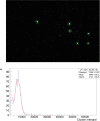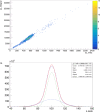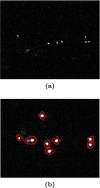Enhancing the light yield of He:CF based gaseous detector
- PMID: 39479476
- PMCID: PMC11519317
- DOI: 10.1140/epjc/s10052-024-13471-5
Enhancing the light yield of He:CF based gaseous detector
Abstract
The CYGNO experiment aims to build a large ( m ) directional detector for rare event searches, such as nuclear recoils (NRs) induced by dark matter (DM), such as weakly interactive massive particles (WIMPs). The detector concept comprises a time projection chamber (TPC), filled with a He:CF 60/40 scintillating gas mixture at room temperature and atmospheric pressure, equipped with an amplification stage made of a stack of three gas electron multipliers (GEMs) which are coupled to an optical readout. The latter consists in scientific CMOS (sCMOS) cameras and photomultipliers tubes (PMTs). The maximisation of the light yield of the amplification stage plays a major role in the determination of the energy threshold of the experiment. In this paper, we simulate the effect of the addition of a strong electric field below the last GEM plane on the GEM field structure and we experimentally test it by means of a 10 10 cm readout area prototype. The experimental measurements analyse stacks of different GEMs and helium concentrations in the gas mixture combined with this extra electric field, studying their performances in terms of light yield, energy resolution and intrinsic diffusion. It is found that the use of this additional electric field permits large light yield increases without degrading intrinsic characteristics of the amplification stage with respect to the regular use of GEMs.
© The Author(s) 2024.
Figures






















References
-
- G. Bertone et al., Phys. Rep. 405(5), 279 (2005). 10.1016/j.physrep.2004.08.031
-
- F. Mayet et al., Phys. Rep. 627, 1 (2016). 10.1016/j.physrep.2016.02.007
-
- F.D. Amaro, E. Baracchini et al., Instruments 6(1), 6 (2022). 10.3390/instruments6010006
-
- K.M. Zurek, Phys. Rep. 537(3), 91 (2014). 10.1016/j.physrep.2013.12.001
-
- K. Petraki, R.R. Volkas, Int. J. Mod. Phys. A 28(19), 1330028 (2013). 10.1142/s0217751x13300287
LinkOut - more resources
Full Text Sources
Research Materials
